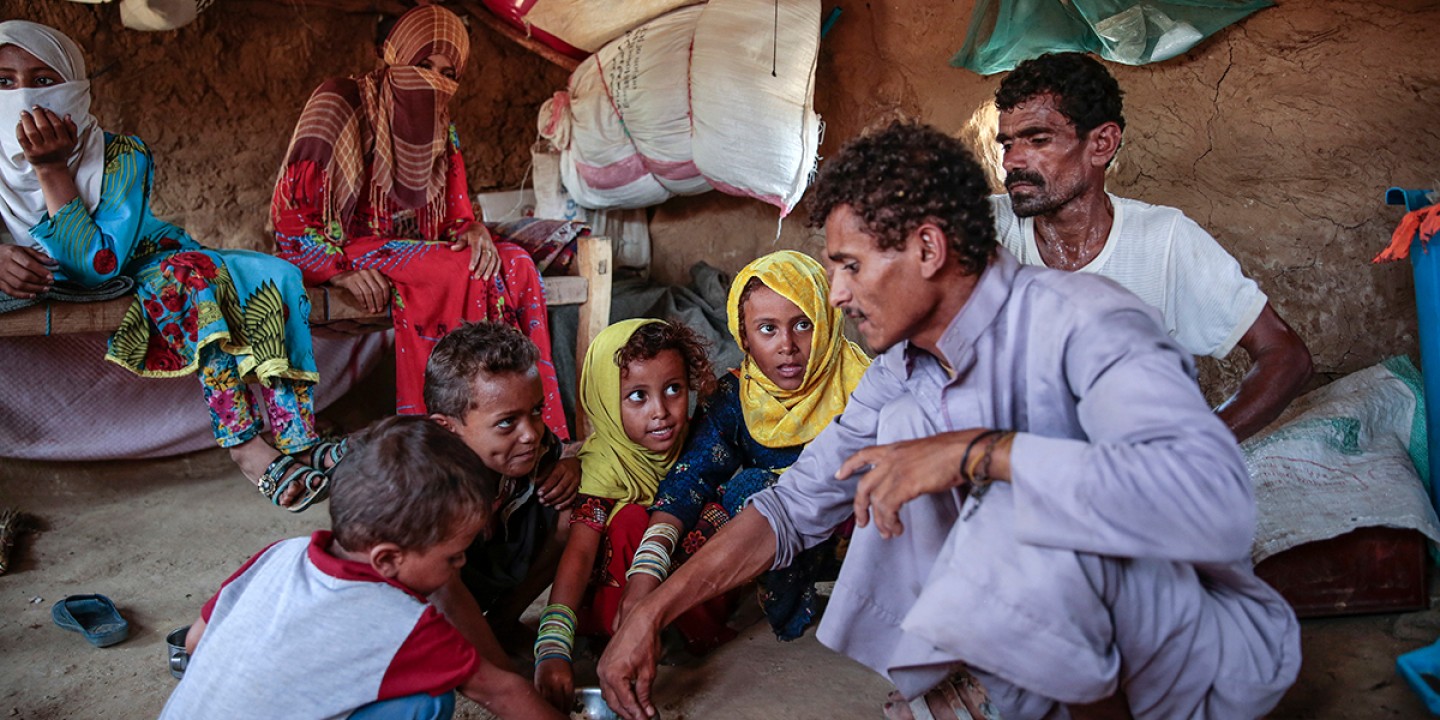
In the past eight years, 10,000 children have been killed or maimed and up to two million more displaced in a war that many people have not heard of. The world’s worst humanitarian crisis is in Yemen, which was already the poorest country in the Middle East when a proxy war between Saudi Arabia and Iran broke out there in 2015. In 2018, I went to Yemen with Matthias Leibbrand, then the CEO of Vision Hope International. Having grown up in a shadow foster care system, I could not ignore the estimates claiming that tens of thousands of Yemeni children became orphans in the first year of the war. Precise numbers are impossible to determine, given the complete collapse of the country’s infrastructure as of December 2015.
More than two-thirds of the Yemeni population is in desperate need of humanitarian aid, and parts of the country have slid into a famine as a blockade has prevented ships laden with food and other essentials from docking in Yemeni ports. Vision Hope has helped thousands of children under age five experiencing malnutrition, but millions more are at imminent risk of starvation.
Read our latest issue or browse back issues.
From a humanitarian perspective, the devastation caused by a proxy war in the region’s poorest country has created an impossible situation: as the country’s food, transportation, healthcare, sanitation, and water systems are destroyed by missiles that target civilians, more people become dependent on foreign aid. Communities quickly lose their resilience—the ability of people to provide for each other through means such as producing food and educating children—thereby creating an ever-worsening humanitarian crisis. In Yemen, there is no end in sight.
One factor may be doing more than any other to drive the conflict: America’s addiction to oil. The reason goes back to a deal struck between US president Franklin Roosevelt and Saudi king Abdul Aziz Ibn Saud in 1945, as World War II was drawing to a close. A few weeks prior to the meeting, the liberation of Auschwitz revealed the horrific scale of Nazi atrocities against European Jews. One of Roosevelt’s goals at the meeting was to persuade the Saudi monarch, a key Arab figure, not to prevent the migration of 10,000 Jews to Palestine.
But Roosevelt had another goal, too: to secure what would become the linchpin of the US economy, unbridled access to cheap oil from the Middle East. Oil strikes by the companies that would become Chevron and Texaco, along with geological surveys, revealed that Saudi Arabia contained so much oil that the center of the global economy would soon shift in that direction. Once it struck a deal to sell oil to the US, Saudi Arabia quickly became immensely wealthy.
In return for a steady supply of oil that would all but guarantee economic prosperity, the United States became deeply committed to protecting Saudi Arabia. But the US also supported the creation of a Jewish state in Palestine. These competing interests created chaos in both the Middle East and the United States in 1973, during the Yom Kippur War, when the US armed Israel against Arab states—including Saudi Arabia—that wanted to force Israel into diplomacy with its neighbors. The result was a six-month oil embargo that nearly crippled the US economy and revealed just how addicted the country was to Saudi oil. Two months after the embargo ended, the US agreed to begin selling weapons to Saudi Arabia in return for guaranteed access to oil.
Oil for weapons has defined US-Saudi relations ever since. As a result, Saudi Arabia has become extremely wealthy and used a portion of its oil revenue to purchase massive amounts of weaponry. American weapons sales to Saudi Arabia were slow at first, as lawmakers believed that flooding the Middle East with firepower could quickly destabilize the entire region. Then the 1979 Islamic Revolution in Iran upended the balance of power in the Middle East. Iran has a Shi’a-majority population, and the revolution spawned a new government based on Ayatollah Ruhollah Khomeini’s ideas of what a Shi’a state should be. When Iranian students raided the American embassy in Tehran a few months after the revolution and took 52 Americans hostage, diplomatic relations between America and Iran came to an end.
Iraq lies between Saudi Arabia and Iran. Its US-backed president Saddam Hussein feared that the revolution in Iran would spread to Iraq’s Shi’a majority; Saudi Arabia, a predominantly Sunni country, shared this concern and came to see Iraq as a buffer state. When Iraq went to war against Iran in 1980, Saudi Arabia was key in arming Hussein’s military.
The brutal war left a million people dead, no significant territory gained or lost on either side, and high tensions between Saudi Arabia and Iran ever since. Analysts have begun referring to these tensions as the Middle East’s Cold War. Saudi Arabia and Iran have never declared war on each other, but they are constantly fighting indirectly by exerting force in other countries throughout the region. Iran has been arming rebel groups in places such as Lebanon and Syria (Hezbollah) and the Palestinian Terrories (Hamas and Palestinian Islamic Jihad). Meanwhile, Saudi Arabia is the de facto head of the Organization of Petroleum Exporting Countries—as well as of the Gulf Cooperation Council, which has solidified Sunni (and Saudi) hegemony in the Persian Gulf.
Yemen is the latest battlefield of this cold war. At the center of the conflict are the Houthis, a Shi’a group from the north of Yemen. The Houthis have a complex history that can be traced back to the ninth or tenth century. For purposes of understanding the war in Yemen, they constituted a resistance movement against Yemen’s long-time president Ali Abdullah Saleh, accusing him of immense corruption. The Houthis are not officially backed by Iran, but because they are a Shi’a group, observers tend to view them as associated with Iran’s interests.
After the Arab Spring in 2011, the Houthis helped overthrow the Saleh government. They resisted Saudi interference, especially when Saudi Arabia, through the GCC, helped instate Abdrabbuh Mansur Hadi as the new president of Yemen and attempted to divide the country into six districts. In a surprising twist, the Houthis allied themselves with Saleh in 2014 (before assassinating him three years later), and Houthi rebels began taking territory in the north of Yemen. When they arrived in Sana’a they assumed control of the capital city, President Hadi fled, and Yemen descended into civil war.
In response to the 2014 Houthi insurgency, Saudi Arabia formed a coalition that consisted of the GCC as well as Western countries, including its primary arms dealer, the United States. By then, the country was awash in US weapons and US petrodollars, both of which it used to begin a bombing campaign on Yemen. While the Saudi government claimed to be targeting Houthi rebel sites, hospitals, schools, markets, and waterways have been devastated in what may have been deliberate attacks.
The Houthi insurgency spelled disaster for Saudi Arabia—largely because of the Bab al-Mandab Strait. The narrow strait off the coast of Yemen is one of the most important shipping channels in the world: it is a major passageway for tankers carrying Saudi and GCC oil. Houthi control of Hodeidah, a major port along the strait, threatens the kingdom’s ability to ship oil. In 2018 Houthi fighters targeted Saudi ships attempting to navigate Bab al-Mandab, leading to both a temporary suspension of Saudi use of the waterway and a renewed bombing campaign. A few weeks later, a Saudi airstrike hit a school bus carrying dozens of children. The bomb used in the airstrike had a US serial number.
There are suggestions that the Houthis have been armed by Iran. While the insurgency operates independently of Iran—it may accept Iranian assistance, yet has shown no intention of conforming to Iran’s bidding —what began as a civil war in Yemen soon devolved into a proxy war between Saudi Arabia and Iran. Like Saudi Arabia, Iran has a stake in access to the Bab al-Mandab Strait; should a Houthi-Iranian alliance lead to Iranian control of the strait, the ramifications would be felt in oil markets all over the world. Whether or not the Houthis have any intention of creating a formal alliance with Iran, the Saudi government seems to act as if this alliance is already in place.
The conflict between Saudi Arabia and Iran may seem at first to be primarily over sectarian differences, Sunni versus Shi’a. But sectarianism seems to be merely exacerbating a struggle that is fundamentally about dominance in the oil industry. Though the war in Yemen is taking place far away from the US, Americans are deeply implicated. The humanitarian aid offered by groups like Vision Hope is essential, and we must hear the pleas of the children who have been orphaned with weapons bought from the US. But the more fundamental need is to work to end America’s dependence on oil.
Short-term humanitarian aid to Yemen remains needed. When the focus shifts to long-term stability and human flourishing in Yemen, we need to already have in place a vision of renewable energy as a way of life in an oil-free society. We can raise questions about this now: How are our homes, churches, and cars powered? How much plastic are we using? Do we regularly buy more than we need? Do our investment portfolios include oil companies? How do our elected representatives, at all levels of government, respond to the need to rapidly end our dependence on oil?
Clean energy is about more than climate justice. Large-scale use of renewable, locally generated energy is the only way to begin ending the relentless war in Yemen. As long as we need oil, future congressional bills to stop the sale of arms to Saudi Arabia may be doomed to fail. If we can end our dependence on oil, we can successfully end those sales and begin imagining a Middle East in which communities can thrive and children whose lives have been shattered by war can begin to heal.





